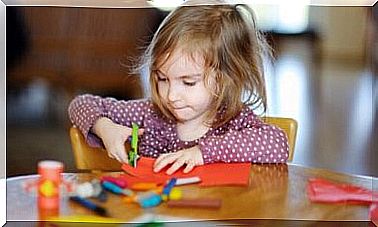Playing Alone, How Can You Stimulate That In Your Child?

In life there are not many things as special as spending a good time with your little one. However, there comes a time when your child has to learn to do things on their own, even if it’s just for a few minutes. That’s why encouraging solo play can come in handy.
Of course, you should always supervise to make sure everything is going well. Your child must be safe and protected at all times. So never forget that small children need constant supervision.
8 ways to encourage alone play in your child
1. Spend some time together in the same room, but alone
It is recommended that you spend some time together in the same room without interacting with each other. Let your little one play with his or her toys while you do something else. This way the child can play alone while you supervise.
You can give your child toys or a book to read. However, try not to give too much, but instead think about concrete play plans before giving certain things.
2. Lead by example

To set a good example, your child needs to see that you are doing certain activities alone. Your child will try to imitate your behavior. For example, you can:
- play with his or her blocks while the child watches
- reading a book
- Paint
- write on a board that your child can use too
Don’t forget to buy things that are non-toxic. Also make sure that they do not contain small parts that could pose a choking hazard for your child.
3. A screen is not a substitute for toys
Do not rely on television, phone games or apps on the tablet to entertain your child. This will transfer the dependent on your child only from you to the screen. This cannot of course be the intention.
The intention is that your child:
- can be on its own
- can play freely
- can make up your own games
- can develop his or her imagination and creativity
4. Provide a safe space
A safe place to experiment is very important for a child. Provide an area where there is no risk of injury. Think for a moment about a play area that meets these requirements. This could be, for example, in their bedroom where everything is prepared in such a way that there is no risk that they will injure themselves.
5. Try not to disturb
Try not to disturb your child when he or she is playing alone. For example, you can let your child play for another 15 minutes even though dinner is already ready.
Be flexible because these rare moments of play are very important for your child’s emotional development. In addition, they help to develop autonomy and independence. The more your child grows, the more important autonomy will become for him or her.
6. Don’t worry about the mess

Don’t get frustrated by the mess you see at home… Play and chaos sometimes go hand in hand. Try to relinquish control every now and then. This will allow your little one to discover the best way to keep themselves occupied.
Of course, playing alone fits in perfectly with this. When the play is over, you can encourage them and let them help clean up the toys. In this way they learn little by little to take responsibility for themselves.
7. Spend some quality time with your child
Letting your child play alone means that he or she will develop more autonomy and independence. However, this doesn’t mean that you don’t have to pay more attention because they ‘need to learn to be alone’.
This is, of course, wrong thinking. Your child also needs to be able to spend quality time with you, so you need to make sure you don’t lose sight of this. You need to limit the time they play alone. In addition, they must enjoy being able to play with you.
8. Step by step
In the beginning it is not easy for a child to be alone. This is no more than normal. It may take a while for them to start playing or they may be satisfied after a few moments of playing alone.
You can start by scheduling just a few minutes of playing alone. As your child gets older, you can extend this to a longer period, depending on the child. Find a balance that suits him or her.









